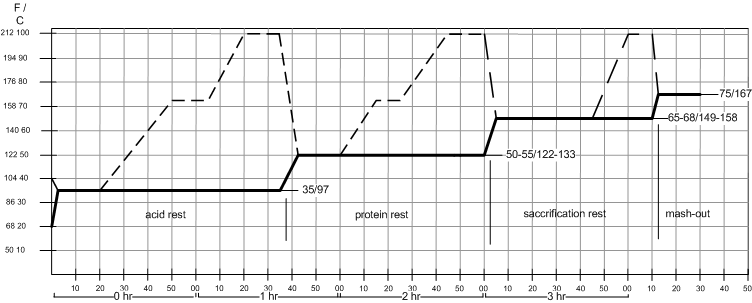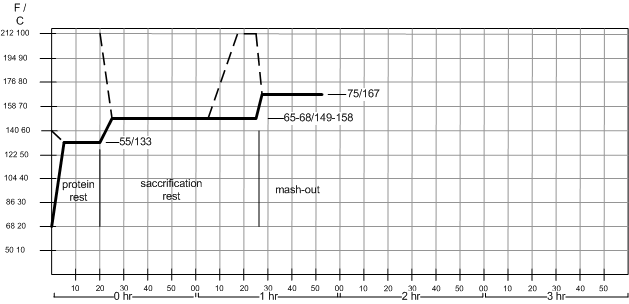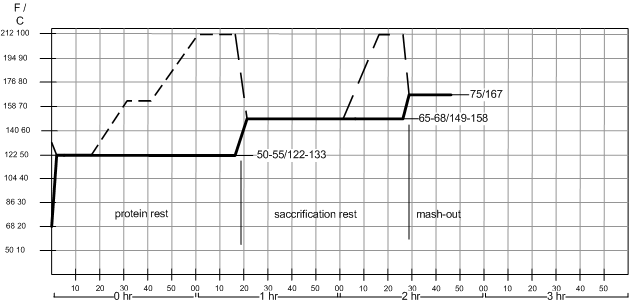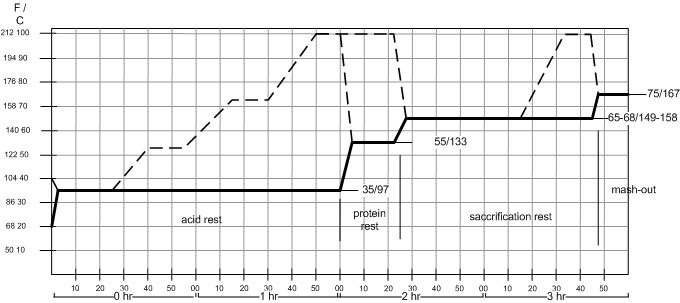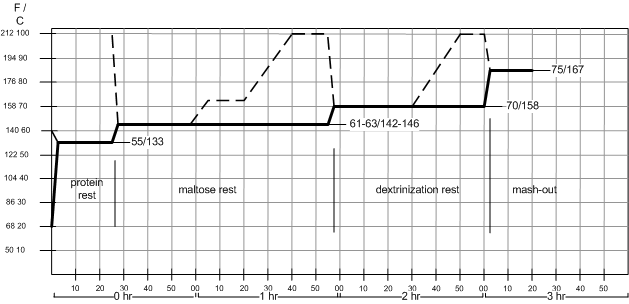A decoction mash is a type of mash in which the various mash temperatures are achieved by removing part of the mash, boiling it in a separate vessel, and then using it as infusion water to heat the remainder of the mash. It is traditional in many continental European beer styles, especially in Germany and the Czech Republic.
Decoction mashing is not common among home brewers, since it has a reputation as a time and labor-intensive process. But a decoction mash is basically just a step infusion mash where some of the grist is heated along with the infusion water. While it does take some extra time and require some extra stirring, it is a procedure that can be performed by most home brewers.
Contents
History of the Decoction Mash
Decoction mashing refers to removing a part of the mash, boiling it and returning it to the main mash to increase its temperature to the next rest. This mashing procedure originates from a time when malt quality was not consistent and temperatures could not be measured. The long boiling of the grain makes the starches more accessible for the enzymes. This is particularly important for undermodified malts where the cell walls are not as broken down as they are in well modified or overmodified malts. The boiling of a defined portion of the mash and returning it to the main mash to raise the temperature also helped the consistency in mashing temperatures before thermometers were available.
Chemistry of the Decoction Mash
Today even most European malts are generally well modified and can be used in infusion step mashes or even single infusion mashes, thus removing the need for decoction mashing. But decoction mashing is still widely used, particularly in German brewing. Many brewers believe that the boiling of the mash gives the beer a flavor profile that cannot be achieved otherwise. But, especially in the home brewing community, there has been debate about the actual benefits of a mash as labor intensive as a decoction mash. Many say that with the malts that are available to the home brewer decoction mashing doesn't make for a difference and if there is a difference it could also be achieved by the use of specialty malts. But in the end every brewer has to determine that for him or herself.
Decoction Mash Procedure
The basic procedure for performing a decoction mash is very simple. Water is added to the grist to reach the initial mash temperature. One the first temperature rest is complete, a portion of the grain and water is scooped or shoveled out of the mash tun and into the kettle or another heated vessel, where it is brought to a boil. The portion removed, which can often be as much as a third of the grist, is called the decoction.
The decoction must be stirred during heating to avoid scorching the grain; this adds some extra work during the mash. The decoction step also adds time to the mash, since unlike the infusion water in a step infusion mash, the water cannot be heated during a rest.
After boiling, the decoction is returned to the mash tun to achieve the next temperature rest.
Sample Decoction Mash Schedules
This section contains discussions of a number of sample schedules for decoction mashes, including single, double, and triple decoctions. The brewer should bear in mind that some mash schedules are better suited for use with modern, well-modified European malts than others.
Triple Decoction
The triple decoction is the grand father of all deoction mashes. This is how the first Pilsners were brewed in Pilzen and how many traditional German breweries brew their dark beers (Munich Dunkel, Bock, Doppelbock) to this day.
The triple decoction mash employs 3 main mash rests: acid rest, protein rest and saccrification rest. from each of these rests a dectcoction is used to reach the next rest until the mash-out is reached. The acid rest is a convinient rest to do mash pH adjustments. Not only does it serve to lower the pH by simply resting at this temperature, but since there is no enzymatic activity that can have a detrimental affect on the final result, there is no rush to move to the next rest.
There are several formulas out there for calculating the decoction volume. Some of them are simple and others try to account for factors such as the heat capacity of the grains and the mash-tun. The easiest way however is to estimate the decoction volume with a simple formula like this:
decoction volume = total mash volume * (target temp - start temp) / (boil temp - start temp)
and add about 15 - 20%. The idea is to deoct more mash than necessary. When the decoction is added back to the main mash, it is not all added at once. Instead it is added in steps while the actual temperature of the mash is constantly checked which requires a thorough mixing of the mash after each addition. Once the target temperature is reached the remaining decoction is left to cool and added once its temperature is close to the mash temperature. By doing so one can account for additional factors that affect the actual needed decoction volume such as: evaporation during the boil, temperatire drop in the main mash and others.
The tickness of the decoction depends on the tickness of the main mash. Though it is preferred to leave a lot of the liquid back in the mash tun, the decoction should not be to thick (grain still being submerged in liquid) to make stirring it easier and keep it from scorching easily. If the main mash can be kept at the preferred thickness of 1.5 - 2 qts/lb (3-4 kg/l) the decotion should have a tickness of 1-1.25 qts/lb (2-2.5 kg/l) this is about the tickness of a standard single infusion mash. At this tickness and with gentle heating, only little stirring is necessary to keep the mash from scorching.
All the decocion schedules provided here assume a deoction rise temp of 2-4 *F/min (1-2 *C/min). This is what is generally recommended in the literature for heating the deoction. There is also a saccrification rest at 155 - 162 *F (68 - 72 *C). The purpose of this rest is to untilize the enzymatic power of the decoction before its enzymes are destroyed by further heating. This is particularily important when brewing beers with a large percentage of the enzymatic weaker dark base malts. This rest doesn't have to be held at the main saccrification temperature. It is sufficient to rest in the alpha amylase range where the conversion is also done much qicker. After the decoction is converted or almost converted (iodine test) the heating of the mash is resumed.
The decoction is then boiled for 10 - 40 minutes. Shorter boil times for light colored beers, longer boil times for dark colored beers. If only gentle heat is applied during the boil, stirring should only be necessary occationally. Similar to wort boiling, excessive thermal loading of the decoction can result in a burnt flavor of the beer. If the deoction is boiled for an extended amount of time evaporation losses can be compensated with the addition of water (which can also be added after the decoction has been pulled, where it helps in tinning it out and makes it more managable) or larger deoction volumes.
Once the decoction is then added to the main mash to reach the protein rest. The temperature and time before pulling the next decoction should be based on the malt that is used. Less modified malts benefit from a rest closer to 122 *F (50 *C) which produces more amino acids, which is an essential yeast nutrient. In undermodified malts the protein conversion has not been diven far enough to allow for sufficient wort FAN (free amino nitrogen) without the use of a more intensive protein rest. If the malt is a well modified modern continental malt, the protein rest temperature should be kept closer to 133 *F (55 *C) and the next decoction should be pulled 5 - 10 minutes after the rest temperature has been reached. This serves to protect more of the medium chained proteins that are important for body and head retention. Or a decoction that allows for a shorter protein rest, which will be described later, should be employed
Again a decoction is pulled, rested for conversion and then brought to a boil. This time to reach the saccrificaton rest temperature. This temperature is similar to the saccrification rest temperature that is used for a single infustion mash, but the same temperature that was used in a single infusion mash may not give the same fermentability in a decoction mash. Boiling has destroyed more of the enzymes while it has made the starch also more easily accessible. The former would lead to a less fermentable result while the latter would shift the fermentability towards a more fermentable wort. This is only to illustrate that fine tuning of the saccrification rest temperature might be necessary for the optimal result. The saccrification rest temperature that would have been used in a single infusion mash is however a good starting point.
Single Decoction
|
This section is a stub.
|
Classic Double Decoction
|
This section is a stub.
|
Enhanced Double Decoction
|
This section is a stub.
|
Hochkurz Double Decoction
|
This section is a stub.
|

